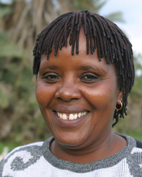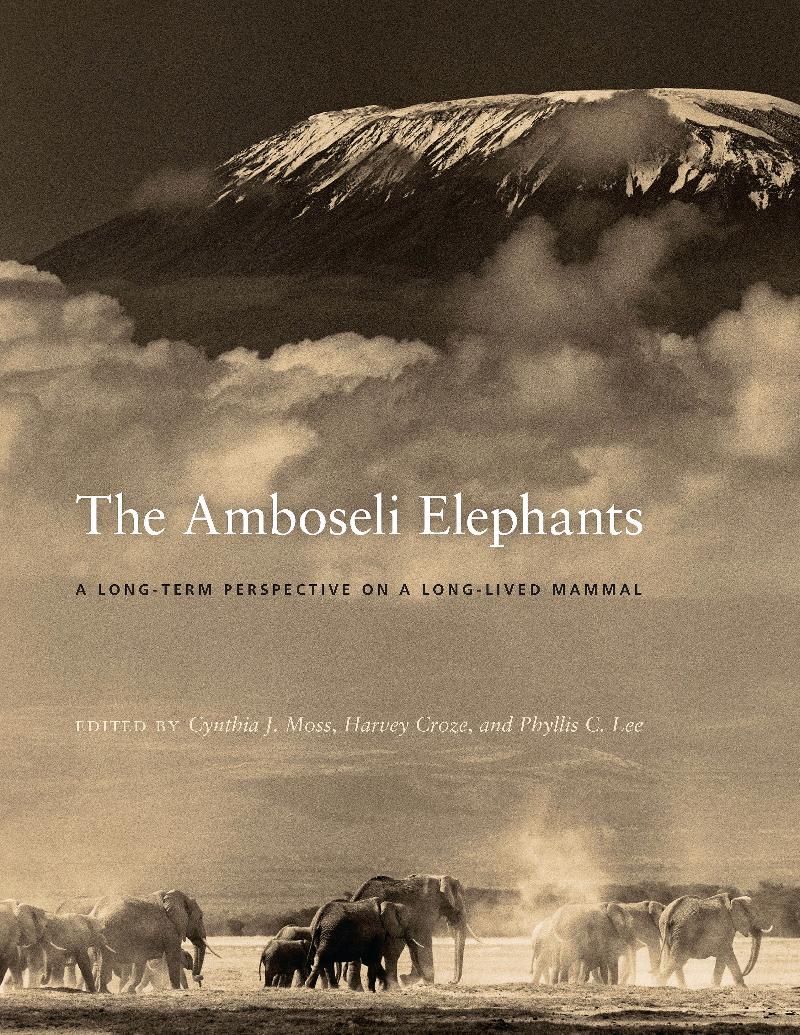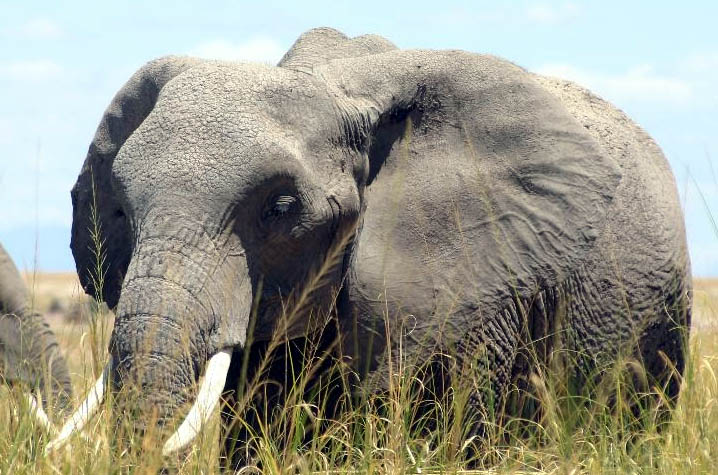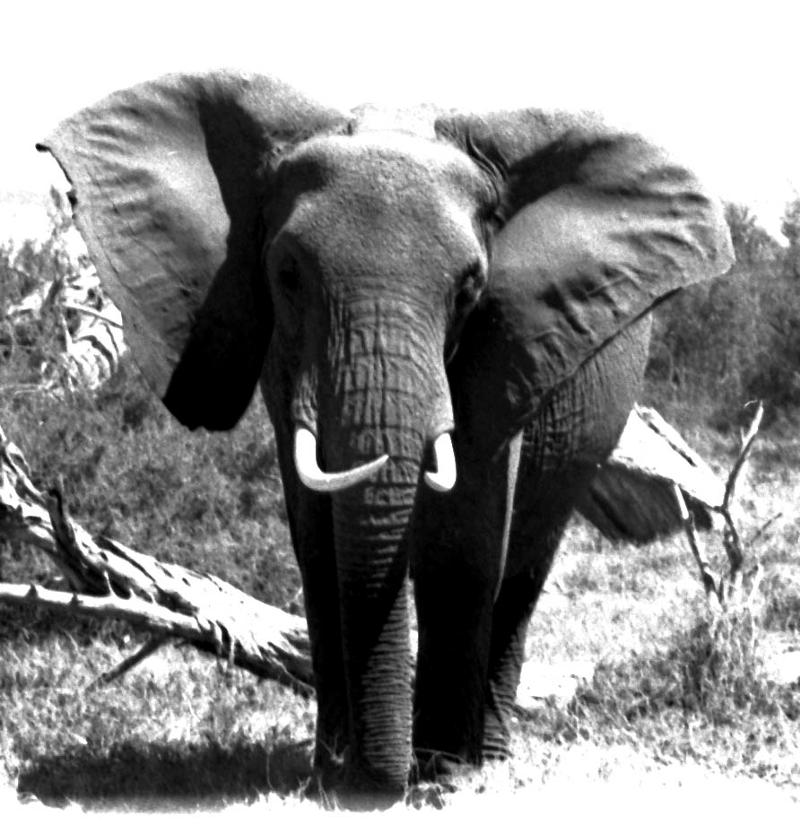 | | Norah Njiraini says... |

Care to Donate now?
|
| Vanity Fair | | A team from Vanity Fair magazine consisting of writer Alex Shoumatoff, photographer Guillaume Bonn and producer Ron Beinner spent three days in Amboseli interviewing Soila, Norah, Katito and me, as well as the KWS Senior Warden and others. We also took them out to see elephants. They are doing a big piece on elephants and ivory poaching for the magazine. It will appear in the March 2011 issue. |
|
| Ph.D. Awarded to Two ATE Colleagues | We are pleased to report that two of our research colleagues were awarded their Ph.D.s in recent months.
Christy Browne-Nunez received her degree from the University of Florida. The title of her thesis is: "Tolerance of wildlife outside protected areas: predicting intention to allow elephants in Maasai group ranches around Amboseli National Park, Kenya." This work is essential in guiding our work on human-elephant relations in the ecosystem.
John Kioko received his Ph.D. in December from Moi University. His thesis focused on the status of critical elephant corridors in the eastern range of the Amboseli elephants. John worked for us for one year and is now a lecturer with the School for Field Studies. | | We congratulate both of these colleagues for receiving their degrees and we thank them for their valuable contributions to conserving the elephants of Amboseli. |

| Amboseli Book
Only two more months until our major tome on the Amboseli elephants is published by the University of Chicago Press. It can be pre-ordered through Amazon. Needless to say, we are very excited about this publication. Already, you can place an advanced order via Amazon.
| |
|
|
|
News from the Amboseli Trust for Elephants
December 2010
|
Greetings!
With Thanksgiving just past and more holidays coming up it is the season to be jolly, and we do have some reasons for celebrating. Amboseli National Park is looking exceptionally gorgeous because we've had light, but steady rains off and on since late October. In camp everything is green, the birds are singing once again, the vervet monkeys are having new babies, the impalas are mating, the warhog piglets are just emerging from their dens, and most important to us, the elephants that come through are fat and relaxed. I know there are still problems for them outside the Park, and I'll write more about that below, but when they're here they are simply enjoying being elephants.
In this issue I've managed to get some of colleagues to contribute articles. I think it makes for a more varied and interesting newsletter. Harvey Croze reports on a retreat of the Kenya Elephant Forum and Soila Sayialel writes about the amazing re-appearance of a young female elephant we thought had died.
I hope things are generally good for all of you who follow our activities and are concerned about the future of the Amboseli elephants. I want to take this opportunity to thank you for your interest and support over the last year. You matter a great deal to us and we appreciate all that you do to keep us going.
Please remember to go to the bottom of this newsletter and click on the Forward to a Friend button below to sign up your friends. We need more people on our mailing list.
With best regards,
Cynthia Moss
Director
Amboseli Trust for Elephants |
|
|
 Two Poachers Shot Outside of Amboseli
On November 25, two poachers were shot dead just south of Amboseli National Park by a Kenya Wildlife Service anti-poaching team. A high-calibre rifle was recovered. A third man was injured but escaped into Tanzania along with two others.
It is very disturbing that people are dying in this battle to protect elephants, and we wish that it hadn't come to this, but people with weapons roaming around near a National Park full of tourists is a major security issue as well as a conservation issue.
KWS needed to send a very strong message that this kind of insecurity cannot be tolerated. We commend the brave rangers who risked their lives.
The poachers were found in the area where two bulls were poached earlier in November. Since the shoot-out the area south of the Park has been quiet, but at least one more elephant was poached to the east of the Park in December.
The two magnificent musth bulls, Sioma and Qaboos, in the photo above are fighting for dominance and the right to mate with females. We have to fight to to make sure these massive, amazing animals can go on with their lives. The war against poaching continues; as long as the demand is out there and the ivory trade is lucrative, elephants will be killed for their tusks. We need to fight on all fronts. Please support our work with a donation.
|
 |
African Elephant Forum Retreat by Harvey Croze
ATE is an active member of the Kenya Elephant Forum (KEF), a lively group of like-minded NGOs who are at the forefront of supporting governments that oppose the ivory trade.
Pat Awori, chairperson of the Pan African Wildlife Conservation Network and convener of KEF, orgainised a two-day retreat at the Elsamere Conservation Centre on the shores of Lake Naivasha during the last week of November.
The purpose was to map out strategic actions necessary to ensure the future of Africa's elephants to be undertaken in the aftermath of the 15th Conference of the Parties of CITES held in Doha last March and the 16th meeting to be held in Thailand in 2013.
 | | Pat Awori (centre, red) and KEF members |
Among a number of specific actions, the retreat elaborated on an exciting new solution for what to do with the tonnes of ivory that Range States are stockpiling from natural mortality and the growing poaching seizures.
Rather than burn the ivory as Kenya did 21 years ago -- spectacular and effective, but terribly wasteful -- how about an Ivory Museum, constructed entirely of whole tusks? Like all innovations, it may sound crazy at first, but the 'Pachy Dome' may just work (you can thank me for the working name; somewhat better than my first suggestion, the 'Tusk Mahal'!).
You can read more details about the retreat at our ATE website. And stay tuned for further developments...
|
 | | Dorothea after her Return |
The Amazing Return of Dorothea
by Soila Sayialel
The prolonged, severe drought of 2009 claimed so many Amboseli elephants, and those losses are evident in the remaining family units that we are recording today. The drought affected the dynamics within the elephant families -- many family units had to split into smaller groups for effective grazing.
One example occurred in the DB family when a young adult female born in 1991, named Dorothea, suddenly disappeared from her group with her eight year-old-female calf named Dahlia. Dorothea is the sixth-born to the matriarch Deborah who is one of the few remaining older matriarchs in the Amboseli population. Dorothea and Dahlia were last recorded in the census sheets on 17 February 2009. The DBs were sighted several times without these two for almost twenty months. During this time we all thought the worst for Dorothea and her calf. In fact, we presumed they were dead.
To everybody's amazement, on the 29th of October 2010, almost two years later, Dorothea and Dahlia re-appeared and, more surprisingly, they were accompanied by Dorothea's one-year-old male calf looking healthy. Dorothea must have accompanied other families that had better luck raising their young calves especially those families that ranged further to the north of Amboseli, such as the VAs, MAs, WAs or KAs. It is a victory to see a young mother being so successful and always a joy to see a new calf come out of a really difficult time.
(To read a complete history of the D families see the next story.)
|
The History of the DA, DB and DC Families
The 'D' females and the families they make up have always been something of a mystery. In fact, the Ds have a history of doing things elephants are not "supposed to do". In the beginning the Ds were thought to be one family. What was eventually designated the DA family was photographed on the very first day of the study on September 1, 1972. Two adult females were present: a large old matriarch whom we named Dorothy and a much younger female we called Dinah. The next time this family was seen on August 4, 1973 there was a third adult female present and she was photographed and named Delia. Over the next few months other females were seen in association with the D females but always in a variety of odd combinations. One female was seen only once and then disappeared. She is simply referred to as the "D female".
 | | Delia in Octber 1973 |
It was not until 1974 that I had some idea of who belonged to the family. It looked like this:
Dorothy Large adult F
3-4 year old calf ?
6-7 year old female calf F
Adolescent male around 10 M
Dinah Adult F
2 year old male calf M
Delia Adult F
Adolescent male around 12 M
Deborah Adult F
Diana Young F
Daphne Young F
In early 1975 Dinah gave birth to a female calf, and on March 26, 1975 I recorded the last sighting of Dorothy. There was poaching of elephants in Amboseli in the mid-70s, but I suspect Dorothy died of natural causes because she had two broken off tusks which would not have been worth killing her for. The young male in the family, who would have been about 17, also disappeared. On May 15th Delia was seen with a new calf, a male.
(The DBs are in the banner photo at the top of this newsletter. Left to right the adult females are Daisy, Deborah, Diz and Dups.)
For the remainder of this history, please go to the ATE website . |
|
All of us at the Amboseli Trust for Elephants wish all of you joyous holidays and a very happy and peaceful New Year.
Cynthia Moss
Amboseli Trust for Elephants |
|
|